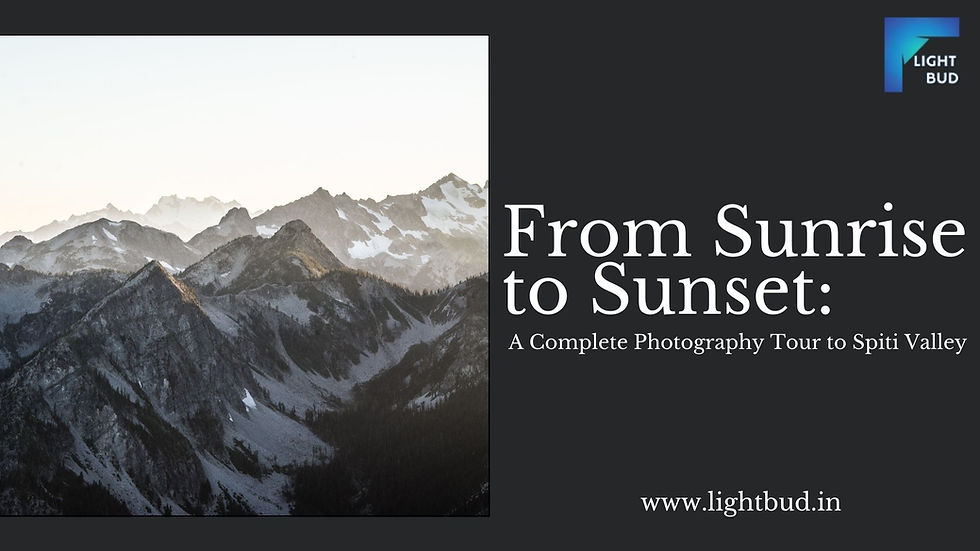- Light Bud
- Apr 7
- 4 min read

Spiti Valley – a land that needs no introduction now, is an ideal space for photography. Its picturesque beauty can often leave you speechless! But amidst all the awe and admiration, do not forget to pick up your camera, for you will regret not capturing the beauty of the valley.
For any Spiti photography tour, there is some bare minimum equipment one needs to carry. Do remember not to carry equipment in excess, as that will only add weight and not utility. Below is a list of equipment we feel is essential, but do let us know in the comments if you feel otherwise:
1. A camera with at least 20 megapixels
Needless to say, one needs to carry a DSLR or Mirrorless camera (and not depend on phone camera), but ensure that your camera is at least a 20 megapixel one. The reason being, if you are using images for digital screens (mobile phones/Laptops) and social media or even prints of A3 size, 20 megapixels would suffice.
More megapixels give more creative freedom in editing photos. You can crop and zoom into photos without worrying about them becoming pixelated or blurry. Also, if you plan for large prints or cropping, aim for 24-36 megapixels or higher.
2. Lenses
The primary function of a camera lens is to gather and focus light from the scene being photographed, creating a sharp and clear image. Different lenses allow photographers to control focal length, aperture, and depth of field, enabling them to capture a wide range of scenes with varying perspectives and levels of detail.
Landscape / travel photography typically needs lenses that offer a wide field of view, sharpness, and good depth of field. One can carry a standard kit lens, typically a zoom lens 18 – 55mm / 18-105mm (crop sensor) or 18-35mm / 24-120mm lens (full frame), which provides a versatile range for general photography. Also, one can use wide-angle (35mm or shorter) or ultrawide-angle lenses (10-24mm) for extreme perspectives or dramatic compositions.
For daylight images f.4-f.22 aperture is perfect, which is provided in standard kit lenses. However, for evening low light situations f1.8-f.4 plays an important role based on your shooting style.
Spiti is also home to exotic wildlife like Blue Sheep, Red Fox, etc. Carry a telephoto lens (70 – 200 mm/ 100 – 400 mm) to capture the incredible wildlife of this valley, or super telephoto lenses with a focal length of 400mm or above.
3. Filters
Lens filters are accessories that attach to the front of a lens. It is a piece of glass/plastic that attaches to the front of a camera lens to modify or enhance the captured image by selectively blocking or allowing certain wavelengths of light.
There are different kinds of lens filters and their uses, but here we will discuss only three of them, which are mainly used in landscape photography.
(i) UV Filter - The basic filter used by most photographers is called a UV filter, which reduces the effects of ultraviolet light,t especially in high altitude or bright conditions, and protects the lens from dust and scratches.
(ii) ND Filter - Neutral Density filters are used to reduce the amount of light entering the lens, allowing longer exposures in bright light conditions. It darkens the scene by blocking the light in F-stop reduction. They come in different f-stop numbers such as ND2, ND4, ND8, etc. Choosing the right strength of ND filter depends on the lighting conditions and the effect you’re trying to achieve.
(iii) Polarizer Filter - A polarizing or CPL (Circular Polarizing) filter is a must-have tool for landscape photography. It can reduce reflections from glass, water, and wet surfaces. It can be used to reduce atmospheric haze and to make the scene look much more vivid.
4. For Astro-photography
Photography tours to Spiti are incomplete if you don’t indulge in some astro-photography under those clear skies of the Middle Land.
Find a dark sky location far from city lights. Next, carry a sturdy tripod with you. Without a tripod, you cannot imagine trying out astro-photography. No human hand is stable enough to hold onto cameras for long exposure shots (like 5-30 minutes).
Invest in a good intervalometer. Also, download a few star tracker apps in which you can see star positions and constellations (like Night Sky).
5. Other Miscellaneous Equipment
A few other equipment is required. For example, use a camera belt/strap. It becomes tedious to put the camera back in the bag after every shot. A strap/belt helps in simply hanging the camera by your shoulders.
Carry at least two sets of batteries. High altitudes tend to drain camera batteries faster.
Also, carry a lens cleaner kit. Spiti is largely a desert valley, and the weather is dry and dusty. A lens cleaning kit will come in handy.
Lastly, carry extra SD Cards, because storage should not be an impediment in shooting!
In case you are going to Spiti through photography workshops or guided photography tours, do reach out to the organisers and ask if they have any other specific equipment, they want you to carry.



